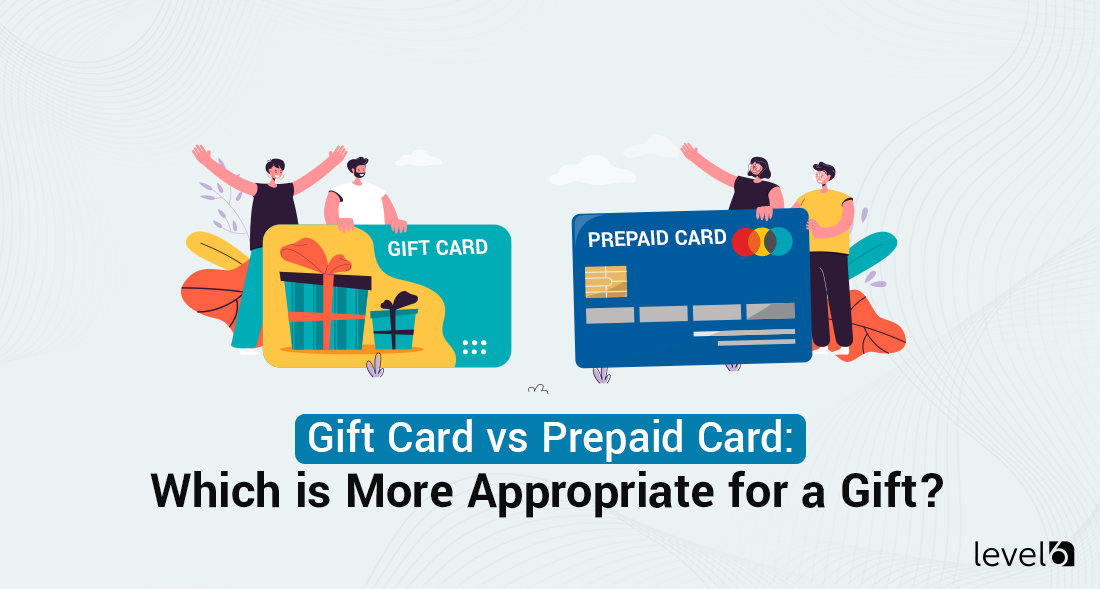Gift Card vs. Prepaid Card: Which is More Appropriate for a Gift?

Any time you consider giving your employees a reward or incentive, you have a decision to make: what form will it take?
You have a budget; that much is certain. Do you spend it on products to give to them? Sometimes that’s fine, but many employees won’t be motivated appropriately or incentivized by some company stationery, a pint glass etched with your logo, or a screen-printed t-shirt.
No, most of the time, you’ll want to give them some form of direct financial incentive. We’ve already discussed the pros and cons of virtual versus physical cards, but now we have another question on our hands: prepaid card or gift card?
In fact, let’s take a step back.
What’s the difference between these two pieces of plastic with money on them, and which one is better to use as a gift, incentive, or motivator?
All About Gift Cards
Gift cards are pieces of plastic with identifying numbers and, sometimes, a magnetic strip on them. They’re issued primarily by retailers (and rarely by credit card companies) and are essentially store credit on a card.
Gift cards are generally a way to give money to someone – with restrictions. It’s not considered cash and can’t be treated like cash. It only applies to specific retailers, whether it’s a local restaurant, a chain of gas stations, or a grocery store.
There are three kinds of broad gift cards worth mentioning, however.
The first is gift cards for megastores. You can use a Walmart or Amazon gift card to buy practically anything because those retailers sell almost anything. It’s almost, but not quite, as good as cash.
Next, let’s discuss the second card type – a “closed loop” gift card.
Looking to learn more about an incentive, rebate
or reward program for your business?
Curious about costs?
Try our instant pricing calculator:
What does that mean?
Closed-loop gift cards are standard gift cards. The money travels in a loop: you pay the retailer to buy a gift card, and you can only use the gift card at that retailer. The money leaves the retailer’s control while it’s on the card, but since it can only be spent with the retailer, it comes back to them eventually, closing the loop.
Closed-loop cards can function for a single retailer, or they can work for an entire group of retailers. For example, you can use a gift card for a restaurant like Carrabba’s at any of their locations across the country, but it’s more flexible than that; those gift cards apply to the entire “Bloomin’ Brands” restaurant group, and you can also use them at Outback Steakhouse, Bonefish Grill, or Fleming’s Steakhouse in equal measure.
Still, the loop is closed within that restaurant system, and the money returns to their hands sooner or later.
By contrast, an open-loop gift card is typically issued by a credit card company like American Express, Discover, Visa, or Mastercard. These cards are generally assigned a fixed value and have a small fee to activate them, after which they can spend the money anywhere that credit card brand is accepted. The loop begins with retailers selling the cards for $X and ends with that money being spent at other retailers.
If this sounds a lot like prepaid cards, well, that’s because it is. There isn’t a whole lot of difference between the two, except for certain restrictions, which may or may not apply depending on the kind of card and the issuer.
All About Prepaid Cards
Prepaid cards are similar to gift cards and similar to cash. More accurately, they’re a form of debit card.
Each prepaid card is issued by a credit card company like Visa or Mastercard, and each one is attached to a debit account, similar to a bank checking account attached to a bank debit card. The card itself has a number and an expiration date, exactly like a standard debit card. The only difference is that rather than having your personal information attached to the account (and consequently, your control over the account), the account is in the name of the credit issuer.
Prepaid cards are, as the name implies, paid in advance. You load an amount of money into the account (be it $20, $500, or however much you want) and then give the card to your employees as a reward. They can then spend that money however they like, at any retailer that accepts cards from that issuer, which is broadly “most of them.” Some, like American Express, have more restricted usage, but the major cards like Visa work pretty much anywhere.
There are two other differences between a gift card and a prepaid card.
The first is that a gift card is generally valueless when it is used up.
It’s a worthless piece of plastic attached to an account with $0 in it and can be safely discarded or recycled. On the other hand, a prepaid card can have money loaded back into it. You can issue a prepaid card to an employee and then, if they earn another reward, can add more money to the same account. They won’t have to juggle multiple cards, though they will have to keep track of one card, which can be a tall order for some people.
The second difference is that a prepaid card usually has a monthly fee.
This fee may or may not apply if the card is left idle for too long, or it may simply apply at all times. The fee is usually small, around $10 per month, but it’s enough to do two things:
- Encourage the employee with the card to use the money or lose it
- Drain idle accounts until they’re empty and can be closed for easier maintenance on the credit card issuer’s end.
Another benefit of a prepaid card over a gift card is that it is, essentially, just cash. In addition to being able to spend it basically anywhere, your employees can also take it to an ATM and withdraw the money as plain cash if they want. They’ll incur an ATM withdrawal fee – usually around $5 – but that’s a small price to pay for the pure flexibility of cash.
Some people also find ways to squeeze extra value out of prepaid cards, especially cards that won’t be reloaded. For example, this lifehack uses empty or near-empty cards as ways to sign up for accounts with automatic billing, to prevent unwanted charges after trial periods. It might not work everywhere, but some people find added value in empty cards this way.
Decide Between Gift Cards and Prepaid Cards
As you can see, prepaid cards and gift cards have a few important differences, but the waters get a little muddier around open-loop gift cards. Open-loop gift cards and prepaid cards are actually very similar, and the differences generally come down to specific terms of use and the arrangement of fees associated with the cards.
The question is, which one should you use for your employee rewards and incentive programs?
Generally, the answer is a choice between restrictions, convenience, and costs.
Gift cards have no fees attached to them. If you issue a $50 gift card and your employee loses it in a pile of paperwork at home and can’t find it for a year, when they finally do find it, it’s still worth $50. On the other hand, a prepaid card with a fee will slowly drain that account, and by the time they find it again, it may be empty.
Of course, not all prepaid cards have steep fees or any fees at all. It all depends on the specific card you get and the terms of use it has attached to it. There’s usually an activation fee on your end, but there may be cards with no fees right away or no fees until it’s been inactive for a certain amount of time.
One of the most significant drawbacks to a gift card is being tethered to a specific retailer or retail group. Even something with as much flexibility as an Amazon gift card can be restricted. Plus, what happens if you give a gift card to an employee as a reward, but they don’t need it?
- A gas card for an employee who doesn’t own a vehicle and takes public transit or bikes to work.
- An Amazon gift card for an employee who has moral objections to supporting Amazon and doesn’t shop at their website.
- A gift card for an outdoor or sporting goods store for an employee who doesn’t enjoy outdoor activities.
It’s not much of an incentive for employees to earn “money” they can’t spend. Right?
There are marketplaces where individuals can sell gift cards for a near-equivalent cash value or swap them with other gift cards they’d be more likely to use, but that’s a third-party, untrusted, and non-viable way of incentivizing your employees. While it’s not uncommon to sell a gift card for the money you can actually use, it’s still not a good backup to rely on when rewarding your employees.
You already don’t want to make them jump through hoops to earn their money; why make them jump through hoops to use it?
The biggest drawback to a prepaid card is the fees, but you can find card programs that have low or non-existent fees, to suit your needs. Fees may also be customizable depending on the volume and value of the cards you’re planning to use.
Another benefit to prepaid cards is customization. With gift cards, they are typically branded with the retailer’s logo that accepts them, with little or no room for customization. Prepaid cards can be customized, and you can even order custom cards with your company’s information on them. It doesn’t quite have the same panache as a company credit card for an expense account, but it’s still a bit of a positive brand association every time your employees use the cards you give them.
So, which should you choose?
Our verdict is prepaid cards.
Why Prepaid Cards Make the Best Incentives
Prepaid cards aren’t ideal for one-off rewards and gifts but are great for ongoing rewards and incentive programs.
Many prepaid cards have fees attached to inactivity, but those fees don’t apply if you either keep the card active or if your employees drain it and leave it empty between uses. Even something as easy as an ATM withdrawal of the value of the card is enough to circumvent pretty much all of the fees. Of course, you’ll choose a prepaid card with the best terms for your business.
The branding of prepaid cards should not be underestimated either. It helps build emotional attachment and resonance to the card and to your company’s rewards program, and that positive reinforcement is a great addition to the incentives you’re building with the program.
By contrast, gift cards are just one-off, potentially off-target gifts. Unless you want to keep a variety of different kinds of cards on hand and allow your employees to choose the card they want, you run the risk of giving them a gift they can’t use. Even asking them to choose can be disincentivizing. A flexible prepaid card is much more functional out of the box.
The only significant downside to prepaid cards is if you’re issuing high volumes of low-value cards. Since these cards have an activation fee, you end up paying more than you would for an equivalent value, either on higher-value prepaid cards or on gift cards. But that’s just more reason to make higher-value rewards for your incentive programs. Right?
If you’re interested in investing in prepaid debit cards branded for your company to use as part of your incentive programs, we’re here to help. You can check out our calculator to see how much such a program will cost, along with other services we offer to make it easier to manage (including customer service, document collection, and tax preparation for the program.)
Alternatively, simply reach out and contact us today, and we can help design a perfect, customized incentive program for your company. We’re happy to review a handful of different options with you that are perfectly tailored to your team and your goals.

Claudine is the Chief Relationship Officer at Level 6. She holds a master’s degree in industrial/organizational psychology. Her experience includes working as a certified conflict mediator for the United States Postal Service, a human performance analyst for Accenture, an Academic Dean, and a College Director. She is currently an adjunct Professor of Psychology at Southern New Hampshire University. With over 20 years of experience, she joined Level 6 to guide clients seeking effective ways to change behavior and, ultimately, their bottom line.
 Demo
Demo






